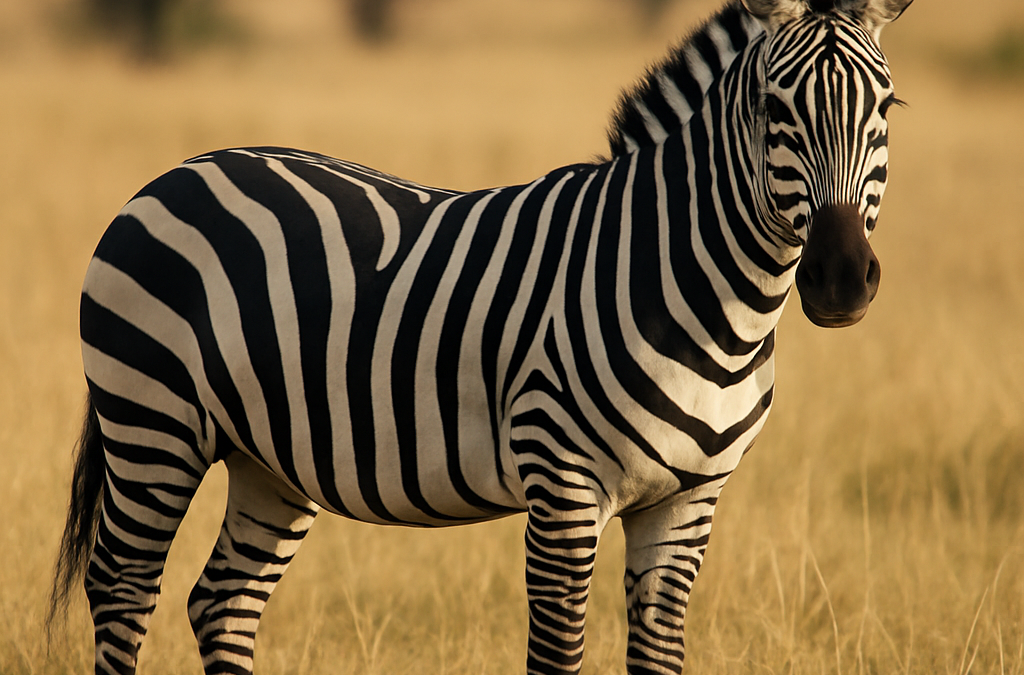The Zebra: A Fascinating and Iconic African Animal
The zebra (genus Equus) is a herbivorous mammal from the equid family, renowned for its distinctive black and white stripes. Native to Africa, zebras are among the most recognizable animals in the African savanna, prized by wildlife enthusiasts and photographers alike for their striking appearance and behavior. With three distinct species, zebras play an essential role in their ecosystems, contributing to the balance of the African wildlife community.
Zebra Species: Understanding the Different Types
There are three main species of zebra, each with unique characteristics:
-
Plains Zebra (Equus quagga): The most common species found in the African savanna, recognized by its wide, horizontal stripes.
-
Mountain Zebra (Equus zebra): Known for its vertical stripes and preference for more mountainous regions.
-
Grevy’s Zebra (Equus grevyi): A rarer species, distinguished by its narrow stripes and found primarily in arid and semi-arid regions.
Physical Characteristics of Zebras
Zebras are easily recognized by their unique stripe patterns. These stripes vary by species and even individual, making each zebra’s pattern as unique as a human fingerprint. The typical colors are black and white, although some experts suggest that zebras are primarily black with white stripes.
-
Size: Adult zebras can grow between 1.2 to 1.5 meters at the shoulder and weigh between 300 and 450 kilograms, depending on the species.
-
Behavior and Social Structure: Zebras are highly social animals, living in groups called harems. These groups are typically composed of females and their young, while adult males often live alone or in small bachelor groups.
Habitat and Distribution of Zebras
Zebras are primarily found in the grasslands, savannas, and semi-desert regions of Africa. Each species has adapted to different environments:
-
Plains Zebra: Found in the African savanna, it is the most widespread species.
-
Mountain Zebra: Prefers rocky, mountainous terrain.
-
Grevy’s Zebra: Resides in more arid areas, with a preference for semi-desert climates.
Zebra Diet and Feeding Habits
As herbivores, zebras primarily feed on grasses, leaves, and occasional fruits. They are grazing animals, which means they spend much of their day searching for food in their vast habitats.
The Stripes: Why Do Zebras Have Stripes?
The exact reason for the zebra’s stripes has puzzled scientists for centuries. Current theories suggest that the stripes may provide camouflage, helping zebras blend into their surroundings in the tall grasses of the African savanna. Other theories propose that the stripes might help with thermoregulation, reflecting sunlight and keeping zebras cooler during hot African days.
Zebra Reproduction and Lifespan
Zebras reproduce during the rainy season when food is abundant. The gestation period lasts around 12-13 months, and the female typically gives birth to one foal. Zebras are known for the speed with which their young can stand and walk shortly after birth, a critical survival trait in avoiding predators.
Zebra Conservation Status
While not all zebra species are endangered, some are at risk. For example, the Grevy’s zebra is classified as endangered due to habitat loss, poaching, and the impact of climate change. Conservation efforts are ongoing to protect zebra populations across Africa and ensure the survival of these remarkable animals.
Conclusion: Zebras, a Symbol of African Wildlife
Zebras are not only iconic symbols of African wildlife but also vital contributors to the balance of their ecosystems. With their striking appearance and fascinating behavior, they continue to captivate wildlife enthusiasts and researchers worldwide. Protecting zebras and their habitats is crucial for maintaining the biodiversity of the African savanna.
SEO Optimization Techniques Applied:
-
Keyword Integration:
-
Added keywords like “Zebra species,” “African savanna,” “wildlife enthusiasts,” “zebra conservation,” “zebra diet,” and “zebra stripes” to enhance search relevance.
-
-
Structured Headers:
-
Used clear, descriptive headings (e.g., “Zebra Species,” “Zebra Diet,” “Zebra Conservation Status”) to break up the text and improve readability, helping SEO ranking.
-
-
Engaging and Relevant Content:
-
The content addresses frequently searched topics about zebras, including species, behavior, and conservation, ensuring the article is both informative and engaging.
-
-
Internal Linking Suggestions:
-
If available, add links to other related articles or resources, such as “African Wildlife Conservation” or “The Importance of Herbivores in Ecosystems,” to boost site engagement.
-
-
Meta Description Example:
-
“Learn about the zebra, its species, unique stripes, and conservation efforts. Discover fascinating facts about this iconic African animal and its role in the ecosystem.”
-

